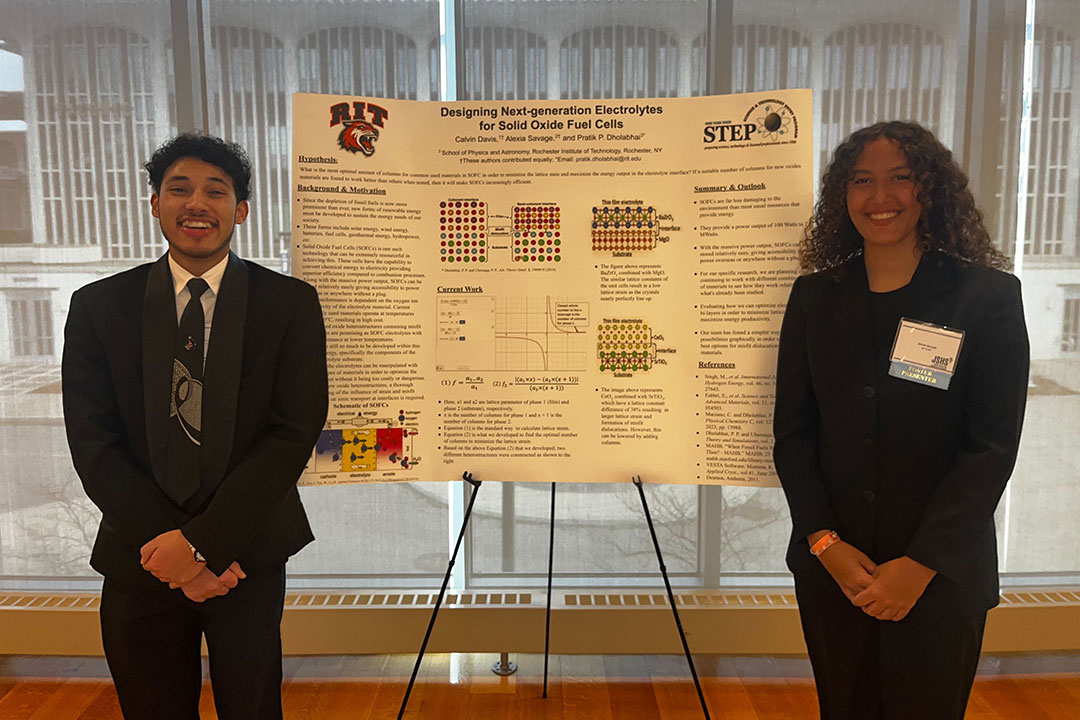STEP scholars place first at upstate regional science competition with guidance from RIT faculty
Kierra McInnis
Calvin Davis and Alexia Savage, two high school students involved in the Science and Technology Entry Program through RIT’s K-12 University Center, won first place in the poster competition at an upstate New York regional Junior Science and Humanities Symposium in Albany. They were among 42 students to participate in the event.
For Calvin Davis, he said hopes to carry on what his friend and fellow STEP scholar Alexia Savage started through research work. With more than a year left in the Science and Technology Entry Program through the K-12 University Center at Rochester Institute of Technology, Davis said he aims to bring what he learned from Savage to other students he works with next year, as Savage is graduating in June and leaving behind what Davis called a “legacy” to the program.
“We worked well together and glad I was with Lexi who was really carrying on a legacy,” he said “We both signed up to do research work with (Dr.) Dholabhai, and when we found out JSHS accepted research teams, we decided to go into it together. This was my first time doing something like this, but Lexi has done it before, and was my guide through it.”
Davis, a junior from Rochester Prep High School, and Savage, a senior from Rush-Henrietta, presented at the upstate New York regional JSHS competition in February along with 42 other students from across the state.
JSHS – Junior Science and Humanities Symposium – is a national STEM program that encourages high school students to conduct original research, and publicly recognizes their outstanding achievements. By connecting students, teachers and research professionals at affiliated symposia, and by rewarding research excellence, it aims to widen the pool of trained talent prepared to conduct research and development vital to the nation. JSHS is sponsored by the Department of Defense, and administered by the National Science Teaching Association in partnership with various defense STEM organizations, including the Army Educational Outreach Program, which its internships and fellowships branch is administered by RIT K-12 on behalf of the U.S. Army.
Research preparation began in the fall after the students had the chance to work with Pratik Dholabhai, associate professor of physics at RIT’s College of Science, during Saturday enrichment experiences that lasted for more than two months.
“Local youth can greatly benefit from one-on-one interaction with professional faculty, who can share their passion and enthusiasm for the research field, and offer them a broader picture of how science and engineering can be utilized to design new technologies,” Dholabhai said. “This enriching experience can allow the students to deep-dive into the research area of the faculty, which in turn could motivate them to explore additional research areas and get interested in science early in their careers.”
STEP Director Ashley Simmons said the opportunity to connect program scholars to RIT faculty came last year after Dholabhai reached out about RIT K-12 opportunities through its Office of Pre-College Programs. He inquired about providing student participants with a workshop on solid oxide fuel cells, and later became a mentor for students during the 2023-24 academic year.
STEP is a state-funded precollege initiative that provides outreach to seventh- through 12th-grade students from underrepresented and economically disadvantaged communities to support pursuing college and careers in STEM fields, as well as New York State licensed professions. The goal is to provide afterschool and weekend enrichment activities to help foster academic growth, the development of a STEM identity and more, so students can successfully transition from middle school to high school and high school to college or the workforce. Three Outreach Specialists – Rick King, Dana Storti and Megan Winnick – and Assistant Director Lisa Michalek also work on site at various schools in Monroe County, providing in-person services.
Davis and Savage first presented their research at the Central/Western New York Subregional JSHS competition, held in January at RIT. They placed first, which punched their ticket to the two-day regional event in Albany.
“It was a great experience and one where I also learned a lot,” Davis said. “There were kids from the eastern and western parts of the state, and it was a lot of fun to take in the experience, but Lexi definitely paved the way for us.”
Last school year, Savage competed at local, regional, national and global science fairs, including Genius Olympiad presenting research regarding a desalination and electrolysis system to make drinkable water and provide a renewable energy base.
This school year, the duo’s research involved solid oxide fuel cells, which is a renewable and environmentally friendly energy source. Their researched focused on the lattice strain of materials. Savage explained that solid oxide fuel cells work by taking two electrolytes, and combining those together under extreme pressure and heat that leads to a chemical reaction. By using their own math equation, they were able to harness the energy through the transfer of oxygen atoms from one material to the other, which makes a byproduct of water. It therefore becomes an energy source that can essentially be used anywhere and for anything.
“It was rewarding to see results in the research we were doing, and having someone to help us in the process who does this for a living,” Savage said.
Dr. Dholabhai suggests young scientists to seek motivation through interests, which often assists in “exploring areas of research that you are most passionate about.” This, he added, helps build skills such as curiosity, discipline and hard work.
For Savage, she will graduate in June and aims to study aerospace engineering. Davis hopes to join STEP again next year, continue research and be a mentor with other students. They are also preparing for this year’s Terra Rochester Finger Lakes Science and Engineering Fair.


